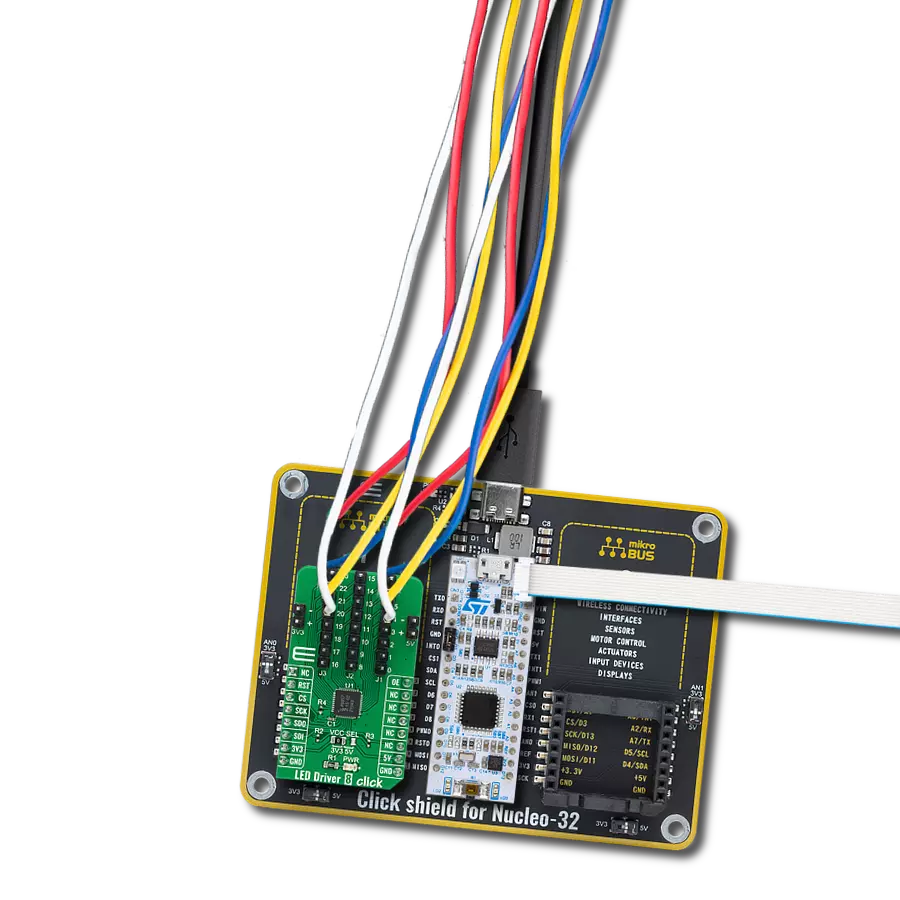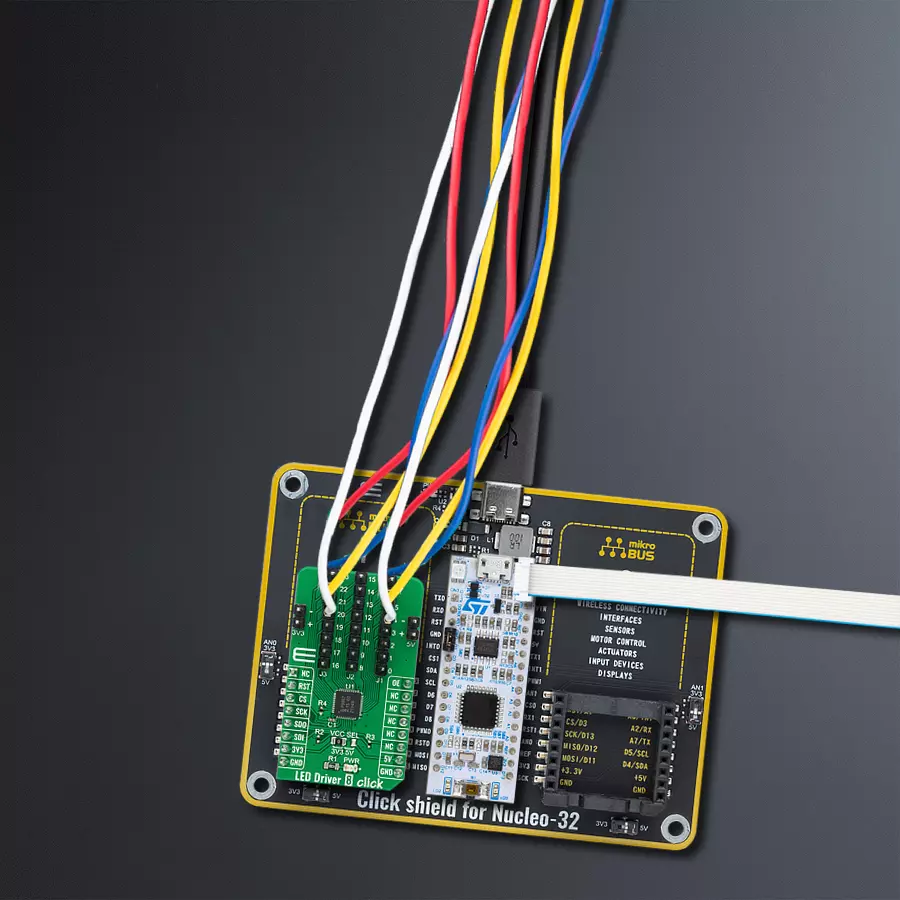Our LED driver is engineered to simplify the integration of LED functionality into your circuit designs, reducing development time and costs
A
A
Hardware Overview
How does it work?
LED Driver 8 Click is based on the PCA9957, a daisy-chain SPI-compatible 4-wire serial bus controlled 24-channel constant current LED driver optimized for dimming and blinking 32 mA RGBA LEDs from NXP Semiconductors. The PCA9957 has 24 internal 8-bit DACs with an operating frequency of 31.25 kHz and a duty cycle from 0% to 100% used to adjust brightness levels for each LED current source. Each LED output is programmable and can be turned off, on (with no PWM control), set at its individual PWM controller value, or both individual and group PWM controller values. Its output peak current is adjustable with an 8-bit linear DAC from 125 μA to 31.875 mA because of the R4 resistor of 2kΩ connected to the REXT pin. Gradation control for all current sources is achieved through a serial interface and
allows the user to ramp current automatically without help from the MCU. It has two operation modes for each group: Single-Shot Mode (output pattern once) and Continuous Mode (output pattern repeat). Each channel can be set to either Gradation Mode or Normal Mode and assigned to any of the six gradation control groups. These groups have four independent registers to control ramp-up and ramp-down rate, step time, hold ON/OFF time, and final hold ON output current. The LED Driver 8 Click communicates with MCU through a daisy-chain SPI-compatible 4-wire serial interface with a clock frequency of up to 10 MHz. The input labeled as OE routed to the PWM pin on the mikroBUS™ blinks all the LED outputs and can be used to externally PWM the outputs, which is useful when multiple devices need to be
dimmed or blinked together without software control. The PCA9957 also has a short load and overtemperature detection circuitry, a thermal shutdown feature that protects the device when the internal junction temperature exceeds the factory-defined limit, and a Reset function routed to the RST pin on the mikroBUS™ which is activated by sending an active low input on this pin with a minimum pulse width of 2.5μs. This Click board™ can operate with either 3.3V or 5V logic voltage levels selected via the VCC SEL jumper. This way, both 3.3V and 5V capable MCUs can use the communication lines properly. Also, this Click board™ comes equipped with a library containing easy-to-use functions and an example code that can be used as a reference for further development.
Features overview
Development board
Nucleo 32 with STM32F031K6 MCU board provides an affordable and flexible platform for experimenting with STM32 microcontrollers in 32-pin packages. Featuring Arduino™ Nano connectivity, it allows easy expansion with specialized shields, while being mbed-enabled for seamless integration with online resources. The
board includes an on-board ST-LINK/V2-1 debugger/programmer, supporting USB reenumeration with three interfaces: Virtual Com port, mass storage, and debug port. It offers a flexible power supply through either USB VBUS or an external source. Additionally, it includes three LEDs (LD1 for USB communication, LD2 for power,
and LD3 as a user LED) and a reset push button. The STM32 Nucleo-32 board is supported by various Integrated Development Environments (IDEs) such as IAR™, Keil®, and GCC-based IDEs like AC6 SW4STM32, making it a versatile tool for developers.
Microcontroller Overview
MCU Card / MCU

Architecture
ARM Cortex-M0
MCU Memory (KB)
32
Silicon Vendor
STMicroelectronics
Pin count
32
RAM (Bytes)
4096
You complete me!
Accessories
Click Shield for Nucleo-32 is the perfect way to expand your development board's functionalities with STM32 Nucleo-32 pinout. The Click Shield for Nucleo-32 provides two mikroBUS™ sockets to add any functionality from our ever-growing range of Click boards™. We are fully stocked with everything, from sensors and WiFi transceivers to motor control and audio amplifiers. The Click Shield for Nucleo-32 is compatible with the STM32 Nucleo-32 board, providing an affordable and flexible way for users to try out new ideas and quickly create prototypes with any STM32 microcontrollers, choosing from the various combinations of performance, power consumption, and features. The STM32 Nucleo-32 boards do not require any separate probe as they integrate the ST-LINK/V2-1 debugger/programmer and come with the STM32 comprehensive software HAL library and various packaged software examples. This development platform provides users with an effortless and common way to combine the STM32 Nucleo-32 footprint compatible board with their favorite Click boards™ in their upcoming projects.
Used MCU Pins
mikroBUS™ mapper
Take a closer look
Click board™ Schematic

Step by step
Project assembly
Track your results in real time
Application Output
1. Application Output - In Debug mode, the 'Application Output' window enables real-time data monitoring, offering direct insight into execution results. Ensure proper data display by configuring the environment correctly using the provided tutorial.

2. UART Terminal - Use the UART Terminal to monitor data transmission via a USB to UART converter, allowing direct communication between the Click board™ and your development system. Configure the baud rate and other serial settings according to your project's requirements to ensure proper functionality. For step-by-step setup instructions, refer to the provided tutorial.

3. Plot Output - The Plot feature offers a powerful way to visualize real-time sensor data, enabling trend analysis, debugging, and comparison of multiple data points. To set it up correctly, follow the provided tutorial, which includes a step-by-step example of using the Plot feature to display Click board™ readings. To use the Plot feature in your code, use the function: plot(*insert_graph_name*, variable_name);. This is a general format, and it is up to the user to replace 'insert_graph_name' with the actual graph name and 'variable_name' with the parameter to be displayed.

Software Support
Library Description
This library contains API for LED Driver 8 Click driver.
Key functions:
leddriver8_set_brightness- Function for set brightnessleddriver8_set_output_gain- Function for set output gainleddriver8_set_mode_register- Function for set mode registers
Open Source
Code example
The complete application code and a ready-to-use project are available through the NECTO Studio Package Manager for direct installation in the NECTO Studio. The application code can also be found on the MIKROE GitHub account.
/*!
* \file
* \brief LedDriver8 Click example
*
* # Description
* This example demonstrates the use of LED Driver 8 Click board.
*
* The demo application is composed of two sections :
*
* ## Application Init
* Initializes the driver and configures the Click board.
*
* ## Application Task
* Increases the LEDs brightness then toggles all LEDs with a one-second delay.
* Each step will be logged on the USB UART where you can track the program flow.
*
* \author MikroE Team
*
*/
// ------------------------------------------------------------------- INCLUDES
#include "board.h"
#include "log.h"
#include "leddriver8.h"
// ------------------------------------------------------------------ VARIABLES
static leddriver8_t leddriver8;
static log_t logger;
// ------------------------------------------------------ APPLICATION FUNCTIONS
void application_init ( void )
{
log_cfg_t log_cfg;
leddriver8_cfg_t cfg;
/**
* Logger initialization.
* Default baud rate: 115200
* Default log level: LOG_LEVEL_DEBUG
* @note If USB_UART_RX and USB_UART_TX
* are defined as HAL_PIN_NC, you will
* need to define them manually for log to work.
* See @b LOG_MAP_USB_UART macro definition for detailed explanation.
*/
LOG_MAP_USB_UART( log_cfg );
log_init( &logger, &log_cfg );
log_info( &logger, "---- Application Init ----" );
// Click initialization.
leddriver8_cfg_setup( &cfg );
LEDDRIVER8_MAP_MIKROBUS( cfg, MIKROBUS_1 );
leddriver8_init( &leddriver8, &cfg );
leddriver8_reset( &leddriver8 );
Delay_ms ( 500 );
leddriver8_output_enable_pin( &leddriver8, LEDDRIVER8_ENABLE_LED_OUTPUTS );
leddriver8_set_output_gain( &leddriver8, LEDDRIVER8_OUTPUT_GAIN_ALL_LED, LEDDRIVER8_FULL_OUTPUT_CURRENT_GAIN );
leddriver8_set_mode_register( &leddriver8, LEDDRIVER8_MODE1_NORMAL_MODE, LEDDRIVER8_MODE2_DMBLNK_DIMMING |
LEDDRIVER8_MODE2_CLRERR_ALL | LEDDRIVER8_MODE2_EXP_DISABLE );
log_info( &logger, "---- Application Task ----" );
Delay_ms ( 500 );
}
void application_task ( void )
{
uint16_t cnt;
log_printf( &logger, "Increasing LEDs brightness...\r\n" );
log_printf( &logger, "----------------------------\r\n" );
for ( cnt = LEDDRIVER8_MIN_BRIGHTNESS; cnt <= LEDDRIVER8_MAX_BRIGHTNESS; cnt++ )
{
leddriver8_set_brightness( &leddriver8, LEDDRIVER8_BRIGHTNESS_ALL_LED, cnt );
Delay_ms ( 20 );
}
log_printf( &logger, "Toggling all LEDs...\r\n" );
log_printf( &logger, "----------------------------\r\n" );
for ( cnt = 0; cnt < 5; cnt++ )
{
leddriver8_set_brightness( &leddriver8, LEDDRIVER8_BRIGHTNESS_ALL_LED, LEDDRIVER8_MAX_BRIGHTNESS );
Delay_ms ( 1000 );
leddriver8_set_brightness( &leddriver8, LEDDRIVER8_BRIGHTNESS_ALL_LED, LEDDRIVER8_MIN_BRIGHTNESS );
Delay_ms ( 1000 );
}
}
int main ( void )
{
/* Do not remove this line or clock might not be set correctly. */
#ifdef PREINIT_SUPPORTED
preinit();
#endif
application_init( );
for ( ; ; )
{
application_task( );
}
return 0;
}
// ------------------------------------------------------------------------ END



































